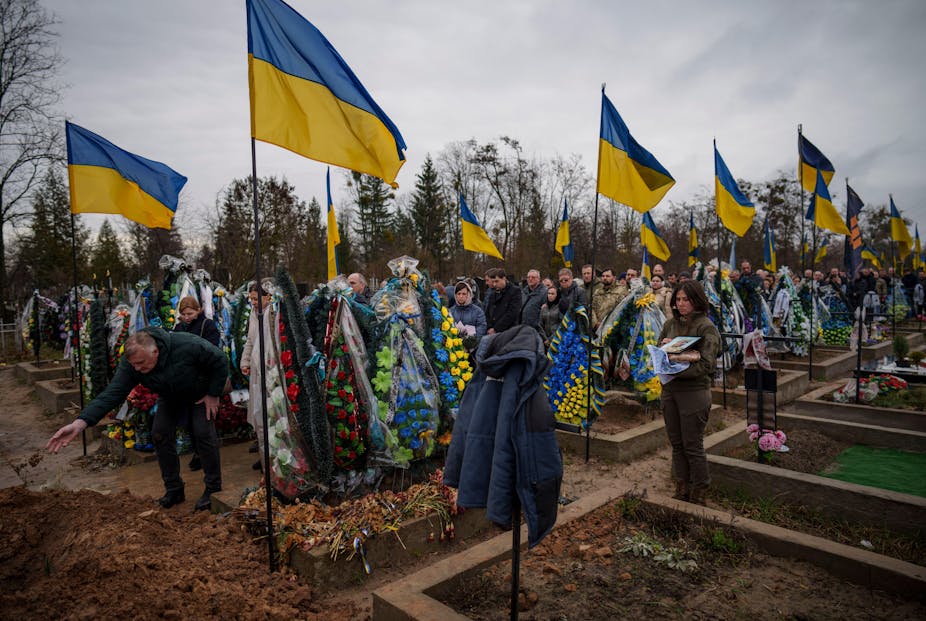Not long ago, the situation in Ukraine could have been characterised as a stalemate. Today, the situation for the defenders is worse, with Ukrainian positions heavily contested along long sections of the frontline. Russian troops are steadily advancing, and concern is building that they might be able to break through.
While not yet gamechanging, these advances indicate that Russia can move forward – and still intends to win the ground war. Backed by aircraft and guided bombs, Russian troops can put pressure on Ukrainian forces, who are overstretched by exhaustion and equipment shortages.
Admittedly, what Russia has been able to accomplish so far doesn’t feel much like winning. They have recaptured some important territory, though the price paid has been ruinous.
The capture of Avdiivka alone cost Russia thousands of troops and hundreds of vehicles. Still, stopping these advances from turning into breakthroughs is costly for Ukraine as well, and despite these losses, Russia is still massing forces for further offensives.
The nature of the frontline is challenging. The presence of drones is increasing the lethality of artillery and making movement difficult.
Both sides are dug in, with extensive networks of trenches and minefields around key locations. Ukraine has done well to hold on but is now approaching a critical moment. Their forces are stretched thin across an extended front line, their western-supplied weapon systems need maintenance, and a shortage of munitions – particularly artillery shells- makes it difficult to react to Russian movements.
Ukrainian difficulties on the front reflect wider challenges. The nation is struggling with conscription, with insufficient skilled troops available to shore up the frontline. As the war drags on, morale is under increasing strain, with two years of conflict taking a toll.

Ukraine’s president Volodymyr Zelensky signed a bill into law on April 2 which lowers the conscription age from 27 to 25. And the Ukraine parliament has just passed a bill to overhaul the country’s system of mobilisation, but details of what the new law will do remain unclear.
Arms shortage
But the key will be providing Ukraine’s armed forces with the weapons it needs to continue the fight. Kyiv needs solutions to Russian air power, ideally in the form of sophisticated air defence systems, as well as more artillery and missiles.
Some of these assets are becoming increasingly hard to acquire, however. Donor nations are contending with their own depleted ammunition stockpiles, and production is still well short of what is needed on the frontlines.
Both Europe and the US are stepping up their arms production, but this will take time. Recent windfalls, such as the shipment of seized Iranian arms sent to Ukraine by the US are helpful, but a consistent supply is harder to secure.
In addition to production problems, the political will to back Ukraine is fading. Support for the war has moved from a broad international consensus into a contentious political issue in both Europe and America.
While Ukraine still has vocal supporters around the world, aid packages are becoming more difficult to secure. This was demonstrated in Europe in February. And while the Biden administration is still working hard to get weapons to Ukraine, it has to contend with other international conflicts and mounting domestic pressure.
A recent rebellion by house Republicans shows how controversial the issue of Ukraine funding is becoming. The looming US election will undoubtedly introduce further challenges, particularly given the prospect of a second Trump presidency.
The Washington Post recently reported on what it called Donald Trump’s secret, long-shot plan to end the war in Ukraine". This, the newspaper report said, would involve “pushing Ukraine to cede Crimea and the Donbas border region to Russia”. At present though there has been no indication from Kyiv that Zelensky would entertain either of those two options.
Russia on top … for now
For their part, the Russians are adapting to the nature of the war. The Putin regime remains in control and has the backing of 77% of the Russian public, according to a poll taken on February 6.
Moscow can out-conscript Kyiv and accept severe casualties with greater ease. Its economy is shifting to reflect its commitment to a long war, and it has developed workarounds to evade western sanctions.
A steady, supply of equipment is ensured through its domestic arms industry and international partners. Russia has capabilities that Ukraine do not, and it is figuring out how to use them. As a result, it has been able to take the initiative.
By summer, Russia will be able to bring its force to bear. It has already begun shaping the battlefield, attacking Ukrainian positions with guided bombs in preparation for further major attacks. They have massed significant ground forces, certainly enough to present a problem for defending Ukrainian troops.
But Russia will be unable to sustain the offensive for long – particularly if they keep suffering casualties at their current rate. The situation on the ground doesn’t lend itself to advancing, and Russia is experiencing many of the problems that the Ukrainians encountered last year.
On top of this, they are still making costly mistakes. A recent major attack north-west of the recently captured city of Avdiivka in the Donetsk region was repelled by Ukraine – reportedly with huge losses of men and armoured vehicles.
But this is no reason to be complacent. Looking at other campaigns particularly their wars in Chechnya, it is possible to suggest that while Russia is willing to fight long and costly wars of attrition, the decisive factor may be external support. This is what distinguishes Ukraine from the wars Russia has fought within its own territory. Both Europe and America need to understand that failure to adequately support Ukraine could have disastrous consequences.

